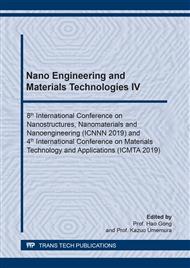[1]
A. Halicka, P. Ogrodnik and B. Zegardlo, Using ceramic sanitary ware waste as concrete aggregate,, Construction and Building Materials, vol. 48, pp.295-305, (2013).
DOI: 10.1016/j.conbuildmat.2013.06.063
Google Scholar
[2]
C. Medina, M. Sánchez de Rojas and M. Frías, Reuse of sanitary ceramic wastes as coarse aggregate in eco-efficient concretes,, Cement and Concrete Composites, vol. 34, no. 1, pp.48-54, (2012).
DOI: 10.1016/j.cemconcomp.2011.08.015
Google Scholar
[3]
Asa-inc.org.au. (2019). Electric Arc Furnace Slag. [online] Available at: http://www.asa-inc.org.au/products/electric-arc-furnace-slag [Accessed 31 Jul. 2019].
Google Scholar
[4]
Juan A, Medina C, Guerra MI, Llamas B, Morán JM, Tascón A. Re-use of construction and demolition residues and industrial wastes for the elaboration or recycled eco-efficient concretes. Span J Agric Res 2010;8(1):25–34.
DOI: 10.5424/sjar/2010081-1140
Google Scholar
[5]
Gomes M, de Brito J. Structural concrete with incorporation of coarse recycled concrete and ceramic aggregates: durability performance. Mater Struct;42(5):663–75, (1999).
DOI: 10.1617/s11527-008-9411-9
Google Scholar
[6]
K. Garg and K. Kapoor, A Review on Ground Granulated Blast-Furnace Slag as a Cement replacing material,, International Journal of Engineering Research and Management, vol. 3, no. 7, pp.214-217, (2016).
Google Scholar
[7]
P. Arulsivanantham and R. Gokulan, A Review on Self Compacting Concrete,, International Journal of ChemTech Research, vol. 10, no. 11, pp.62-68, (2017).
Google Scholar
[8]
Khayat K. H., Workability, Testing and Performance of Self Consolidating Concrete,, ACI Materials Journal, Vol. 96, No. 3, pp.346-354, May-June (1999).
DOI: 10.14359/632
Google Scholar
[9]
ASTM International. (2017). ASTM C1621/C1621M-17 Standard Test Method for Passing Ability of Self-Consolidating Concrete by J-Ring. Retrieved from https://doi.org/10.1520/C1621_C1621M-17.
Google Scholar
[10]
British Standards Institution. (1998). BS EN 12350-10:2010: Testing fresh concrete. Self-compacting concrete. L box test. Retrieved from http://www.standardsuk.com/.
Google Scholar
[11]
British Standards Institution. (1998). BS EN 12350-9:2010: Testing fresh concrete. Self-compacting concrete. V funnel test. Retrieved from http://www.standardsuk.com/.
DOI: 10.3403/30210222u
Google Scholar


